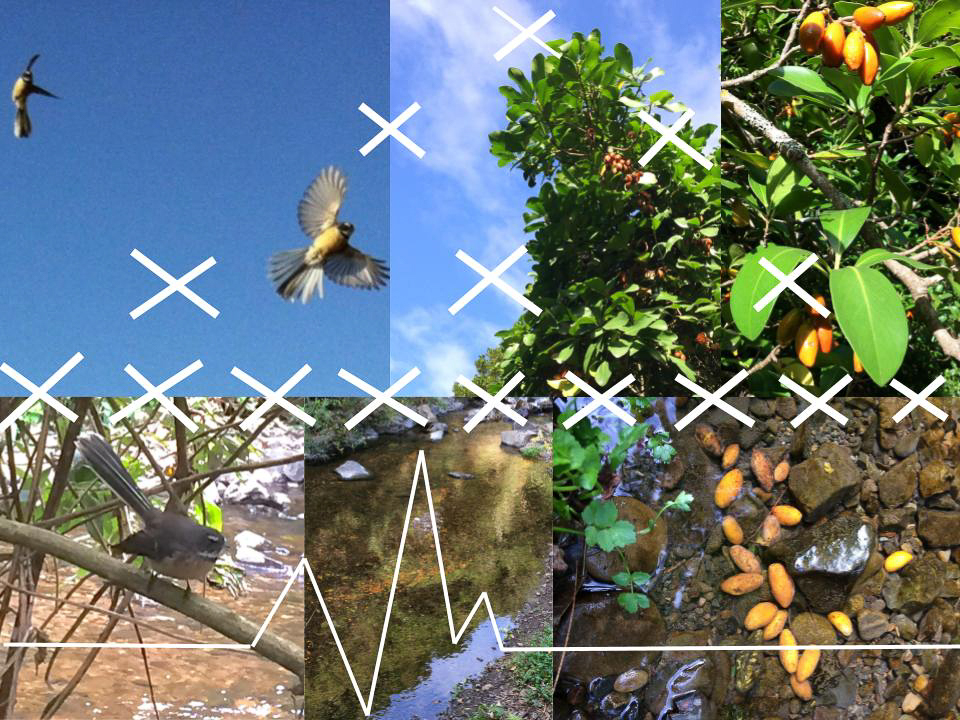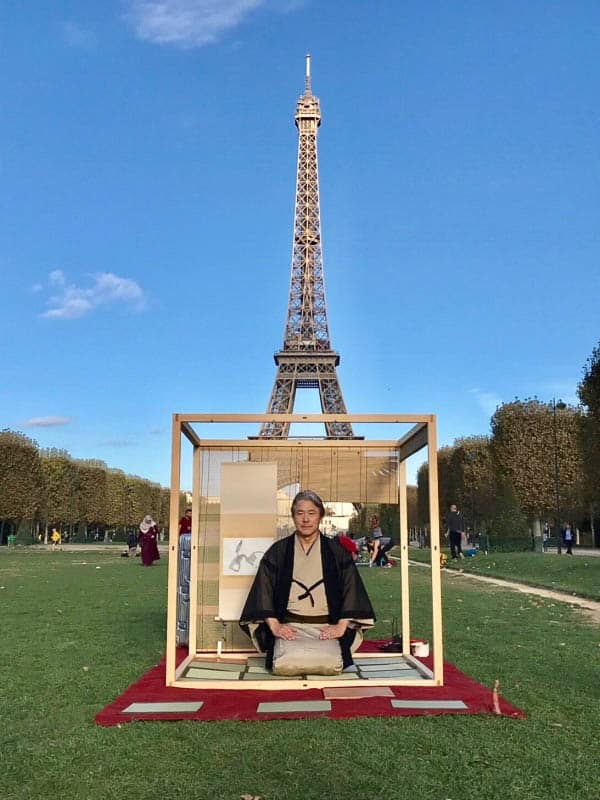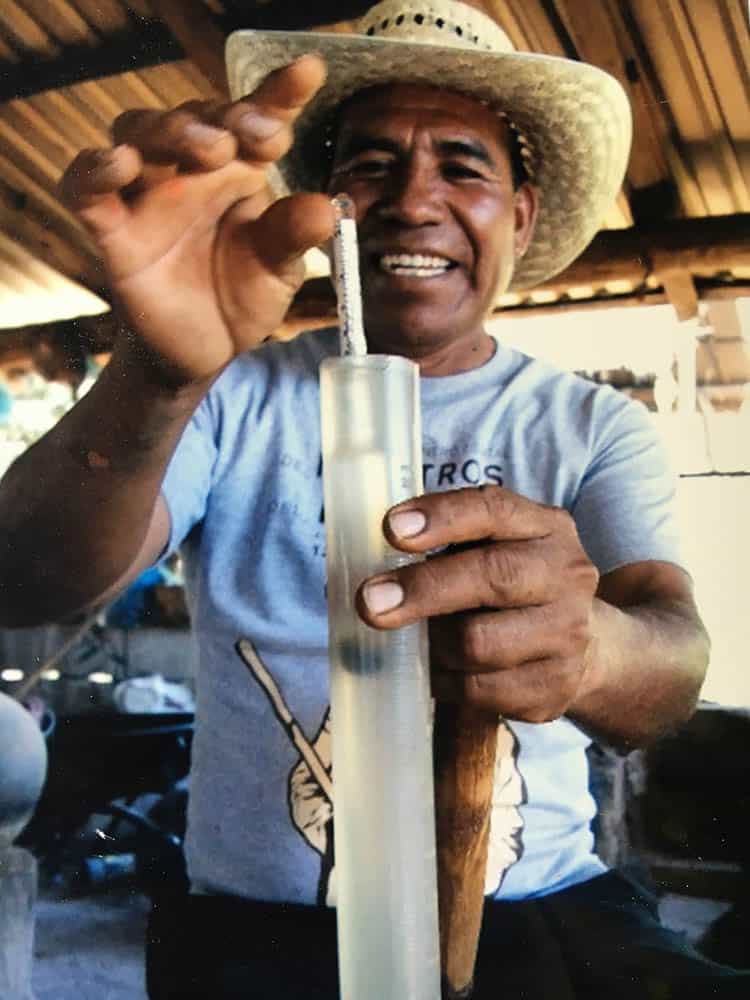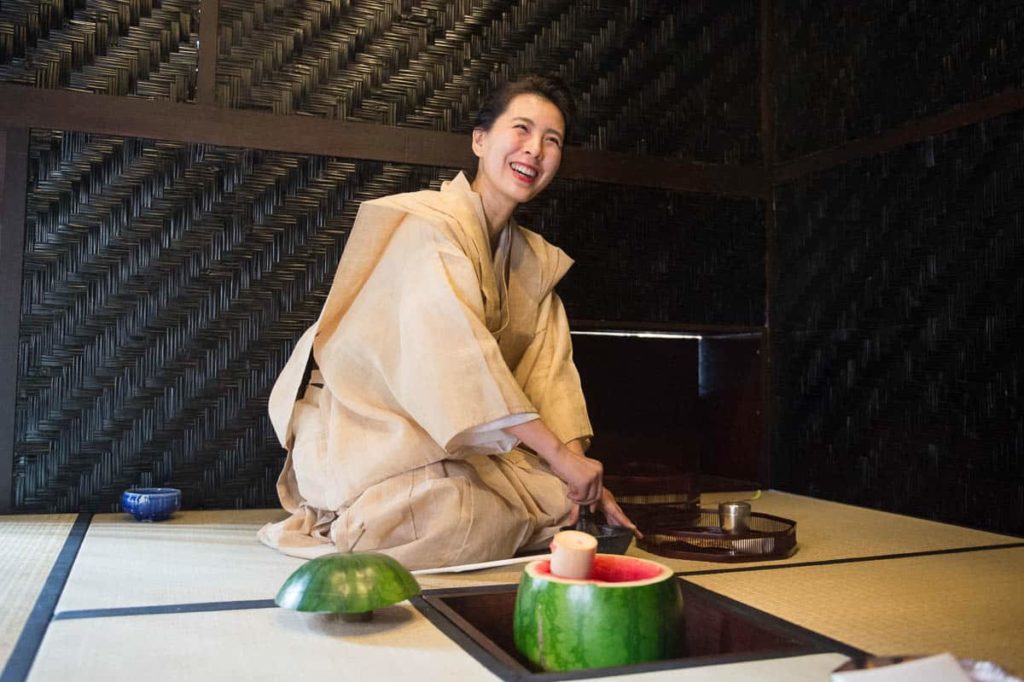
Erika Kobayashi’s performing a tea ceremony at Minhocão (literally, Great Worm, an elevated highway in downtown São Paulo, Brazil) on August 6th in solidarity with the victims of the Hiroshima atomic bombing. She wears a kimono received as a gift and Mona Caron’s mural is “improvised” as a chabana (tea flowers). Photo by Jennifer Glass, 2017.
This is a time to rest and imbibe some restorative food and drink. The plate on which the food sits and the cup that you bring to your lips, all have stories to tell.
Kakuzō Okakura describes the way many senses come together in the traditional Japanese tea house, Sukiya, in his Book of Tea (1906). He describes the importance of what we hear in the tea room.
The kettle sings well, for pieces of iron are so arranged in the bottom as to produce a peculiar melody in which one may hear the echoes of a cataract muffled by clouds, of a distant sea breaking among the rocks, a rainstorm sweeping through a bamboo forest, or of the soughing of pines on some faraway hill.
Enjoy the feast of stories shared by Garland contributors about the value of how we eat and drink.
✿
 In search of mathh, a sugar craft for ingesting a sacred spirit - Kaustav Chatterjee visits Santipur in West Bengal to find the maker of a unique sacred consumable.
In search of mathh, a sugar craft for ingesting a sacred spirit - Kaustav Chatterjee visits Santipur in West Bengal to find the maker of a unique sacred consumable.
 Sarah Khan ✿ Spoons as weapons of mass creation - Our September laurel Sarah K Khan, inspired by a sixteenth-century Indian Cookbook in Persian, decorates her spoons in honor of women’s knowledge.
Sarah Khan ✿ Spoons as weapons of mass creation - Our September laurel Sarah K Khan, inspired by a sixteenth-century Indian Cookbook in Persian, decorates her spoons in honor of women’s knowledge. The Magill commission: Ceramics to savour - Lauren Murphy's tableware commission met precise criteria of aesthetics, functionality, and durability.
The Magill commission: Ceramics to savour - Lauren Murphy's tableware commission met precise criteria of aesthetics, functionality, and durability. Introduction: A taste of the world - Liliana Morais introduces the Taste-Makers issue, whose stories reflect the sense of place, gustatory experience of objects and ways of coming together.
Introduction: A taste of the world - Liliana Morais introduces the Taste-Makers issue, whose stories reflect the sense of place, gustatory experience of objects and ways of coming together.  Tea house - This is a time to rest and imbibe some restorative food and drink. The plate on which the food sits and the cup that you bring to your lips, all have stories to tell.
Tea house - This is a time to rest and imbibe some restorative food and drink. The plate on which the food sits and the cup that you bring to your lips, all have stories to tell. Pine water jug: Imbibing the Taurus mountains - Songül ARAL writes about the traditional pine jug that captures the bracing air of the Taurus mountains.
Pine water jug: Imbibing the Taurus mountains - Songül ARAL writes about the traditional pine jug that captures the bracing air of the Taurus mountains.  Taste-makers: A selection of tableware made by hand today - You are invited to sample tableware by today's makers from around the world.
Taste-makers: A selection of tableware made by hand today - You are invited to sample tableware by today's makers from around the world. Biohacking a fermented community - Jahan Rezakhanlou observes the lessons of fermentation and biohacking learned from the communal artwork and workshops of Maya Minder.
Biohacking a fermented community - Jahan Rezakhanlou observes the lessons of fermentation and biohacking learned from the communal artwork and workshops of Maya Minder. Towards an Indigenous Australian Iranian cuisine - Jahan Rezakhanlou deconstructs the idea of "authenticity" in Iranian cuisine by experimenting with Indigenous Australian ingredients in Melbourne-Naarm, straying away from either tokenistic fusion labels or the home-grown demands of "authentic" foreign food in the West.
Towards an Indigenous Australian Iranian cuisine - Jahan Rezakhanlou deconstructs the idea of "authenticity" in Iranian cuisine by experimenting with Indigenous Australian ingredients in Melbourne-Naarm, straying away from either tokenistic fusion labels or the home-grown demands of "authentic" foreign food in the West. Rēwena bread: A nourishing food with its own whakapapa - Keri-Mei Zagrobelna shares her love of Māori bread and its starter bug that is passed down through generations.
Rēwena bread: A nourishing food with its own whakapapa - Keri-Mei Zagrobelna shares her love of Māori bread and its starter bug that is passed down through generations. Estudio Trindade and Rondinelly Santos ✿ Brazilian for life - Maria Fernanda Paes de Barro writes about two Brazilian tableware makers who bring a particular creative energy to the rituals of everyday life.
Estudio Trindade and Rondinelly Santos ✿ Brazilian for life - Maria Fernanda Paes de Barro writes about two Brazilian tableware makers who bring a particular creative energy to the rituals of everyday life. Mann-o-Salwaa: Savouring the food of the heavens - Sahr Bashir evokes the rich culinary history of her Pakistani homeland, kept alive in the silversmithing that adorns it.
Mann-o-Salwaa: Savouring the food of the heavens - Sahr Bashir evokes the rich culinary history of her Pakistani homeland, kept alive in the silversmithing that adorns it.  Chefs who make - Lee Tran Lam finds four remarkable chefs who make their own tableware, uniquely crafted for their specialist dishes.
Chefs who make - Lee Tran Lam finds four remarkable chefs who make their own tableware, uniquely crafted for their specialist dishes. Taste and rongoā Māori: The art of experience - Arihia Latham describes the importance of taste as a life energy in rongoā, Māori medicine.
Taste and rongoā Māori: The art of experience - Arihia Latham describes the importance of taste as a life energy in rongoā, Māori medicine. A kimono for food: Hikibaku chopsticks for honoured guests - Serendouce Crafts commissioned Nishijin brocade maker Kohei Murata to apply the lustrous kimono textile technique to a set of chopsticks.
A kimono for food: Hikibaku chopsticks for honoured guests - Serendouce Crafts commissioned Nishijin brocade maker Kohei Murata to apply the lustrous kimono textile technique to a set of chopsticks. James Tylor ✿ In search of mai - Prompted by the experience of foraging in Europe, Caitlin Eyre accompanies James Tylor on a quest to recover the taste of native Australian bush foods.
James Tylor ✿ In search of mai - Prompted by the experience of foraging in Europe, Caitlin Eyre accompanies James Tylor on a quest to recover the taste of native Australian bush foods. Ajiwau: A Japanese way of savouring life - Euan Craig shares his life at the wheel in a Japanese pottery village, where he makes tableware that helps savour the food and its moment.
Ajiwau: A Japanese way of savouring life - Euan Craig shares his life at the wheel in a Japanese pottery village, where he makes tableware that helps savour the food and its moment. Gilty: Consuming contemporary jewellery - In her audacious exhibition, Claire McArdle invites the audience to consume and destroy her precious jewellery.
Gilty: Consuming contemporary jewellery - In her audacious exhibition, Claire McArdle invites the audience to consume and destroy her precious jewellery. Make and bring your own chopsticks - We ask Vipun Chanchlani about the challenge of making your own chopsticks and how we should bring our own to restaurants.
Make and bring your own chopsticks - We ask Vipun Chanchlani about the challenge of making your own chopsticks and how we should bring our own to restaurants. Foraging among the ruins of satoyama in rural Japan - Daniela Kato writes about the foraging practices that she shares with a village community under the mountain's shadow.
Foraging among the ruins of satoyama in rural Japan - Daniela Kato writes about the foraging practices that she shares with a village community under the mountain's shadow. Blended imaginaries: In conversation with Gina Zupsich, tea art director - Ben Lignel interviews tea-blender Gina Zupsich about the gustatory and imaginary anchor points that underpin a powerful tea experience.
Blended imaginaries: In conversation with Gina Zupsich, tea art director - Ben Lignel interviews tea-blender Gina Zupsich about the gustatory and imaginary anchor points that underpin a powerful tea experience.  Cone Eleven ✿ Crafting a theatre for specialist dining - Ilona Topolcsanyi collaborates with two chefs, demonstrating the creative role of the ceramicist in specialist dining.
Cone Eleven ✿ Crafting a theatre for specialist dining - Ilona Topolcsanyi collaborates with two chefs, demonstrating the creative role of the ceramicist in specialist dining.  The underlying delight of Japanese tableware - The Go for Kogei festival invited Brian Kennedy to dialogue with Kutani ceramicist Masaru Nakada in developing a playful set of tableware.
The underlying delight of Japanese tableware - The Go for Kogei festival invited Brian Kennedy to dialogue with Kutani ceramicist Masaru Nakada in developing a playful set of tableware. The herb that must not be named - Divya N writes about a jewellery made with herbs that protects children from harm.
The herb that must not be named - Divya N writes about a jewellery made with herbs that protects children from harm. Terra ferment: Three recipes - Ilka White shares three recipes that reflect the same grounded sensibility that she applies to her weaving practice.
Terra ferment: Three recipes - Ilka White shares three recipes that reflect the same grounded sensibility that she applies to her weaving practice. You Stir the Pot: Recipes for change - Victoria Manganiello tells us about a social change project that invites artists to apply their creativity to making recipes for a better world.
You Stir the Pot: Recipes for change - Victoria Manganiello tells us about a social change project that invites artists to apply their creativity to making recipes for a better world.  A spoon a day - Ana Sincu reflects on how making spoons helps her form a deep connection to the trees she loves.
A spoon a day - Ana Sincu reflects on how making spoons helps her form a deep connection to the trees she loves. A gaiwan for my father - Mia Riley revisits her father's tea cabinet and resolved to use her ceramic skills to make him special traditional tea cups.
A gaiwan for my father - Mia Riley revisits her father's tea cabinet and resolved to use her ceramic skills to make him special traditional tea cups. Erika Kobayashi ✿ A tea ceremony for Brazil - Liliana Morais interviews Brazilian performer Erika Kobayashi about how she updates the Japanese tea ceremony to suit the pulse of life in Brazil.
Erika Kobayashi ✿ A tea ceremony for Brazil - Liliana Morais interviews Brazilian performer Erika Kobayashi about how she updates the Japanese tea ceremony to suit the pulse of life in Brazil. Jayanto Tan ✿ Delights for every palette - Pamela See interviews Jayanto Tan about the role of brightly coloured food in his installations.
Jayanto Tan ✿ Delights for every palette - Pamela See interviews Jayanto Tan about the role of brightly coloured food in his installations. Brasilidade: Samba on a plate - Nina Coimbra’s tableware captures the feeling of “Brasildade”, the poly-sensory experience of life in Brazil.
Brasilidade: Samba on a plate - Nina Coimbra’s tableware captures the feeling of “Brasildade”, the poly-sensory experience of life in Brazil. Kamaladevi Chattopadhyay on “the right kind of spoon” - Aarti Kalwa introduces the lecture by Kamaladevi Chattopadhyay which advocates for the idea of world craft.
Kamaladevi Chattopadhyay on “the right kind of spoon” - Aarti Kalwa introduces the lecture by Kamaladevi Chattopadhyay which advocates for the idea of world craft. Staining lips red for centuries: The heart-shaped betel leaf - The MAP Academy share the rich ornamental culture involving the consumption of paan, stuffed betel leaf, in India.
Staining lips red for centuries: The heart-shaped betel leaf - The MAP Academy share the rich ornamental culture involving the consumption of paan, stuffed betel leaf, in India. A wooden spoon: How to make life special - Eli Bek explains why he makes tableware from wood, as a way of "making special".
A wooden spoon: How to make life special - Eli Bek explains why he makes tableware from wood, as a way of "making special". Victor Meertens: Off Cuts - Gregory Pryor reflects on the career of a sculptor whose drive to dissect the world takes surprising forms, including breadmaking and musical performance.
Victor Meertens: Off Cuts - Gregory Pryor reflects on the career of a sculptor whose drive to dissect the world takes surprising forms, including breadmaking and musical performance. Oceans in a tea cup - Alma Studholme admires the work of Jayanto Tan and reflects on her own work that bridges migration with the warmth of a teacup.
Oceans in a tea cup - Alma Studholme admires the work of Jayanto Tan and reflects on her own work that bridges migration with the warmth of a teacup. Mid-Autumn Festival: A time to make many blessings under the same moon - Wishing a long life to share the graceful moonlight, though thousands of miles apart. 但愿人长久,千里共婵娟
Mid-Autumn Festival: A time to make many blessings under the same moon - Wishing a long life to share the graceful moonlight, though thousands of miles apart. 但愿人长久,千里共婵娟 The world in a tea towel: Weaving cartographic abstractions - Nien Schwarz weaves connections to the land, transforming maps into tea towels for everyday use.
The world in a tea towel: Weaving cartographic abstractions - Nien Schwarz weaves connections to the land, transforming maps into tea towels for everyday use. Tecuil Alessia: Preserving the heart of the prehispanic kitchen - Raquel Bessudo heralds a new design for the traditional stove which promises a healthy future for traditional Mexican life
Tecuil Alessia: Preserving the heart of the prehispanic kitchen - Raquel Bessudo heralds a new design for the traditional stove which promises a healthy future for traditional Mexican life The shoemaker and the goat breeder - Carolina Hornauer tells a story about Planea foundation and how it helps pair complementary crafts for local benefit.
The shoemaker and the goat breeder - Carolina Hornauer tells a story about Planea foundation and how it helps pair complementary crafts for local benefit. Robin Best ✿ A tea journey in silver and blue - Antonia Harrison writes about Robin Best's five vase garniture, made in Jingdezhen and telling the story of tea from China.
Robin Best ✿ A tea journey in silver and blue - Antonia Harrison writes about Robin Best's five vase garniture, made in Jingdezhen and telling the story of tea from China. Kuniji Tsubaki ✿ Hinraku, c’est bon! - If you want to get real about de-cluttering, embrace the spirit of hinraku, as in the portable tea room by architect Tsubaki Kuniji.
Kuniji Tsubaki ✿ Hinraku, c’est bon! - If you want to get real about de-cluttering, embrace the spirit of hinraku, as in the portable tea room by architect Tsubaki Kuniji.  Why you should drink saké hot - Masahiro and Yumi Takahashi present their projects Sakenet and Dear Plastic that export a hightenned Japanese sensibility to the other side of the world.
Why you should drink saké hot - Masahiro and Yumi Takahashi present their projects Sakenet and Dear Plastic that export a hightenned Japanese sensibility to the other side of the world.  Why do Koreans use metal chopsticks? - Unlike other Asian cultures whose chopsticks are primarily made of wood, Korean chopsticks are made of metal. Why?
Why do Koreans use metal chopsticks? - Unlike other Asian cultures whose chopsticks are primarily made of wood, Korean chopsticks are made of metal. Why? Ollas de barro y mezcal - El padre de Lázaro Monjaraz caminaría dos días a pie desde el remoto pueblo de Yutanduchi de Guerrero, sobre áridas colinas cargadas de palmeras, a través de ríos, picos arbóreos de casi 3000 metros y finalmente al valle central de Oaxaca hasta el pueblo de Atzompa, donde compraría las nuevas vasijas de barro que necesitaba para destilar el mezcal.
Ollas de barro y mezcal - El padre de Lázaro Monjaraz caminaría dos días a pie desde el remoto pueblo de Yutanduchi de Guerrero, sobre áridas colinas cargadas de palmeras, a través de ríos, picos arbóreos de casi 3000 metros y finalmente al valle central de Oaxaca hasta el pueblo de Atzompa, donde compraría las nuevas vasijas de barro que necesitaba para destilar el mezcal. Slow made tradition in Oaxaca - Ehren Seeland connects the intensive making of mole sauce to the textile crafts renowned in Oaxaca
Slow made tradition in Oaxaca - Ehren Seeland connects the intensive making of mole sauce to the textile crafts renowned in Oaxaca Ollas de barro y mezcal – Pots of clay and mezcal 🇲🇽 - Rion Toal details the exquisite skill involved in fermenting mezcal
Ollas de barro y mezcal – Pots of clay and mezcal 🇲🇽 - Rion Toal details the exquisite skill involved in fermenting mezcal Rirkrit Tiravanija materialises in Singapore - Mae Ueda introduces watermelon mixed with matcha for a tea ceremony suitable to steamy Singapore.
Rirkrit Tiravanija materialises in Singapore - Mae Ueda introduces watermelon mixed with matcha for a tea ceremony suitable to steamy Singapore. Lively hood - Patrick Jones describes the myth, arts and ferments that both “claim” and nourish the performance collective, Artist as Family.
Lively hood - Patrick Jones describes the myth, arts and ferments that both “claim” and nourish the performance collective, Artist as Family.
